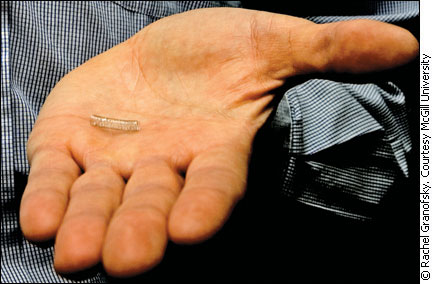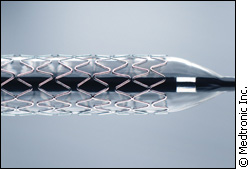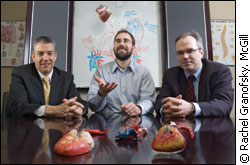
|
Children born with shrunken arteries often need a tiny tube to prop open the vessel so the blood can flow to the lungs to be oxygenated. The device, called a stent, acts as a delicate metal scaffold that keeps a tight artery open wide. It’s a common device for adults, who suffer from coronary artery disease in much higher numbers. But for the one per cent of children who will need a stent at some point, there is no equivalent device. Doctors are stuck forcing parts that aren’t designed for kids into their tiny arteries. "In some situations, doctors have taken existing stents and modified them just to have something to put into a (child). So it’s really out of desperation,” says Richard Leask, a William Dawson Scholar and a professor of chemical engineering at McGill University in Montreal. It’s a piecemeal answer to a persistent problem. But there may be a solution in sight. Wrong tool can spell disaster Leask and his colleague, Rosaire Mongrain, a mechanical engineering professor at McGill and co-director of the Montreal Heart Institute’s Cardiovascular Engineering Lab, have spent three years developing a stent specifically for children. As biomedical engineers, they work closely with doctors to find out how their designs can help improve medical devices. One colleague, Dr. Josep Rhodés, a pediatric cardiologist at Laval Hospital in Quebec City, expressed his frustration with the lack of adequately designed stents for children. “He’d seen too many disastrous cases where you have to put the wrong tool in to solve the problem,” Leask says of Dr. Rhodés. Mongrain and Leask aren’t the first ones to make a stent just for kids. Several companies in Europe market a small version of an adult stent. One company based in the United States, NuMed Inc., was fined $2 million last year because it bypassed the FDA's approval process to get the stents to kids faster. “There are probably 100 times or more in the last year where I said ‘That’s it! I don’t want to do it anymore,’” says Allen J. Towers, CEO of NuMed Inc. “But that’s not an option that I have, because no one else is doing it.” But Leask says making the proper-sized tool is not as simple as making a kid-sized version of an adult stent. Most cases of coronary artery disease in adults are caused by a build-up of fatty plaque in the arteries which restricts blood flow.
Children with narrow arteries are born with the condition. In an adult, you’re trying to open up a stiff, rigid artery with a metal scaffold. With a child, it’s usually a very elastic artery, and the stents are not designed to deal with that,” says Leask. Complications occur because stents designed to prop up stiff adult arteries can rub against the flexible arteries of a child. This could injure or even rupture the blood vessel, which could lead to death, according to Leask. So Leask and Mongrain took a different approach. First, they scrapped the mesh-like design of traditional stents. They needed something that could adapt to the flexibility of a child’s blood vessel, while still keeping the artery open. A breath of fresh air Their inspiration for their pediatric stent is a breath of fresh air. A rib cage provided Mongrain and Leask's inspiration. “It’s designed to ultimately grow with the child,” says Leask. “It’s got the ability to expand and open up like a rib cage.” Mongrain and Leask hope the new design will solve two major problems. First, then new stent will be more flexible and less likely to injure the artery. But they hope the stent will have more lasting benefits. Unlike an adult stent, which has a maximum diameter, the new stent should be able to expand limitlessly. “An adult doesn’t grow. You blow it up once, and that’s the diameter you want, you’re good,” says Leask.
According to Leask, the stent should attach to the inner walls of the artery, which would enable the stent to expand on its own and keep the artery open as the child grows. “But as a fallback we can go in and inflate it almost to infinity,” says Leask. In March, Mongrain and Leask will begin testing the new stent in animals. It’s their fourth prototype, but the engineers are convinced that they’ve perfected the design. "A lot of doctors would take this stent right now and put it in a kid because they have no other options, but ethically you can’t do that,” says Leask. Saving lives vs. making money Instead, they’ll have to rely on Baylis Medical Inc. to bring the stent to the market. The medical equipment manufacturing and distribution company was approached by Mongrain and Leask about collaborating on the stent. Baylis provides approximately $25, 000 per year in financial backing, matched by a grant from the National Sciences and Engineering Research Council (NSERC). But Leask is more worried about whether the stent will actually be marketed to hospitals. Since hospitals sign contracts with major medical supply companies, the hospitals are unable to turn to other companies, such as the smaller NuMed or Baylis, to buy pediatric stents. “The pediatric cardiology market is a niche market. A lot of the bigger companies don’t bother to go into it because they can’t make a lot of money,” says Baylis. It’s a statement that is echoed by Allen J. Tower. Despite his company’s legal woes, he’s still optimistic. “We get a lot of reports from pediatric cardiologists all over the world telling us how much we’re needed,” says Tower. “We do save a lot of children’s lives.”
|
|
|


